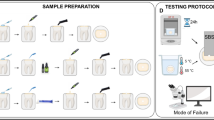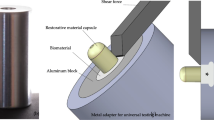Abstract
The objective of this study was to compare the one-week bonding effectiveness of nine contemporary composite cements used to lute ceramic to dentin and to determine an appropriate processing method for pretesting failures. The microtensile bond strengths (µTBS) of different luting agents including five self-adhesive cements (Unicem, 3 M ESPE; Maxcem, Kerr; Monocem, Shofu; G-Cem, GC; and Multilink Sprint, Ivoclar-Vivadent), two self-etch cements (Panavia F2.0 and Clearfil Esthetic Cement, Kuraray), and two etch-and-rinse cements (Calibra, Dentsply, and Variolink II, Ivoclar-Vivadent) were measured using a standardized protocol. As control, a two-step self-etch adhesive combined with a restorative composite (Clearfil SE+Clearfil APX, Kuraray) were included as luting material. Depending on the processing of the pretesting failures, two groups of cements could be distinguished: (1) those with low bond strength and many pretesting failures and (2) those with relatively high bond strength and few pretesting failures. Nevertheless, the control luting procedure involving a self-etch adhesive combined with a restorative composite presented with a significantly higher µTBS. The µTBS was clearly product-dependent rather than being dependent on the actual adhesive approach. Fracture analysis indicated that failure usually occurred at the dentin–cement interface especially for the cements with low bond strength and many pretesting failures. Depending on the cement system, an adequate immediate ceramic-to-dentin bond strength can be obtained, even with self-adhesive cements that do not use a separate dental adhesive. Yet, the self-etch adhesive Clearfil SE combined with the restorative composite revealed a superior bonding performance and should therefore be preferred in clinical situations where the restoration transmits light sufficiently.


Similar content being viewed by others
References
Saskalauskaite E, Tam LE, McComb D (2008) Flexural strength, elastic modulus, and pH profile of self-etch resin luting cements. J Prosthodont 17:262–268
Van Meerbeek B, De Munck J, Yoshida Y, Inoue S, Vargas M, Vijay P, Van Landuyt K, Lambrechts P, Vanherle G (2003) Buonocore memorial lecture. Adhesion to enamel and dentin: current status and future challenges. Oper Dent 28:215–235
De Munck J, Vargas M, Van Landuyt K, Hikita K, Lambrechts P, Van Meerbeek B (2004) Bonding of an auto-adhesive luting material to enamel and dentin. Dent Mater 20:963–971
Paul SJ, Scharer P (1997) The dual bonding technique: a modified method to improve adhesive luting procedures. Int J Periodontics Restorative Dent 17:536–545
Hikita K, Van Meerbeek B, De Munck J, Ikeda T, Van Landuyt K, Maida T, Lambrechts P, Peumans M (2007) Bonding effectiveness of adhesive luting agents to enamel and dentin. Dent Mater 23:71–80
Van Landuyt KL, Peumans M, De Munck J, Lambrechts P, Van Meerbeek B (2006) Extension of a one-step self-etch adhesive into a multi-step adhesive. Dent Mater 22:533–544
Sidhu SK, Omata Y, Tanaka T, Koshiro K, Spreafico D, Semeraro S, Mezzanzanica D, Sano H (2007) Bonding characteristics of newly developed all-in-one adhesives. J Biomed Mater Res B Appl Biomater 80:297–303
Proenca JP, Polido M, Osorio E, Erhardt MC, Aguilera FS, Garcia-Godoy F, Osorio R, Toledano M (2007) Dentin regional bond strength of self-etch and total-etch adhesive systems. Dent Mater 23:1542–1548
Perdigao J, Gomes G, Gondo R, Fundingsland JW (2006) In vitro bonding performance of all-in-one adhesives. Part I–microtensile bond strengths. J Adhes Dent 8:367–373
Peumans M, De Munck J, Van Landuyt K, Lambrechts P, Van Meerbeek B (2007) Five-year clinical effectiveness of a two-step self-etching adhesive. J Adhes Dent 9:7–10
Phrukkanon S, Burrow MF, Tyas MJ (1998) The influence of cross-sectional shape and surface area on the microtensile bond test. Dent Mater 14:212–221
Phrukkanon S, Burrow MF, Tyas MJ (1998) Effect of cross-sectional surface area on bond strengths between resin and dentin. Dent Mater 14:120–128
Tay FR, King NM, Suh BI, Pashley DH (2001) Effect of delayed activation of light-cured resin composites on bonding of all-in-one adhesives. J Adhes Dent 3:207–225
De Munck J, Van Meerbeek B, Yoshida Y, Inoue S, Suzuki K, Lambrechts P (2004) Four-year water degradation of a resin-modified glass-ionomer adhesive bonded to dentin. Eur J Oral Sci 112:73–83
Van Landuyt KL, Snauwaert J, De Munck J, Peumans M, Yoshida Y, Poitevin A, Coutinho E, Suzuki K, Lambrechts P, Van Meerbeek B (2007) Systematic review of the chemical composition of contemporary dental adhesives. Biomaterials 28:3757–3785
Yoshida Y, Nagakane K, Fukuda R, Nakayama Y, Okazaki M, Shintani H, Inoue S, Tagawa Y, Suzuki K, De Munck J, Van Meerbeek B (2004) Comparative study on adhesive performance of functional monomers. J Dent Res 83:454–458
Peumans M, Hikita K, De Munck J, Van Landuyt K, Poitevin A, Lambrechts P, Van Meerbeek B (2007) Effects of ceramic surface treatments on the bond strength of an adhesive luting agent to CAD-CAM ceramic. J Dent 35:282–288
Stewart GP, Jain P, Hodges J (2002) Shear bond strength of resin cements to both ceramic and dentin. J Prosthet Dent 88:277–284
Roulet JF, Soderholm KJ, Longmate J (1995) Effects of treatment and storage conditions on ceramic/composite bond strength. J Dent Res 74:381–387
Brentel AS, Ozcan M, Valandro LF, Alarca LG, Amaral R, Bottino MA (2007) Microtensile bond strength of a resin cement to feldpathic ceramic after different etching and silanization regimens in dry and aged conditions. Dent Mater 23:1323–1331
Frankenberger R, Sindel J, Kramer N, Petschelt A (1999) Dentin bond strength and marginal adaptation: direct composite resins vs ceramic inlays. Oper Dent 24:147–155
Ozturk N, Aykent F (2003) Dentin bond strengths of two ceramic inlay systems after cementation with three different techniques and one bonding system. J Prosthet Dent 89:275–281
Behr M, Rosentritt M, Regnet T, Lang R, Handel G (2004) Marginal adaptation in dentin of a self-adhesive universal resin cement compared with well-tried systems. Dent Mater 20:191–197
Chieffi N, Chersoni S, Papacchini F, Vano M, Goracci C, Davidson CL, Tay FR, Ferrari M (2006) Effect of the seating pressure on the adhesive bonding of indirect restorations. Am J Dent 19:333–336
Chieffi N, Chersoni S, Papacchini F, Vano M, Goracci C, Davidson CL, Tay FR, Ferrari M (2007) The effect of application sustained seating pressure on adhesive luting procedure. Dent Mater 23:159–164
Acknowledgments
The authors would like to thank the manufacturers for supplying materials for this study.
K. L. Van Landuyt has been granted a Postdoctoral Research Fellowship of the Research Foundation-Flanders (FWO). This study was supported in part by the FWO No. G.0206.07 and the KULeuven OT/06/55 research grants.
Conflicts of interest
There are no conflicts of interest.
Author information
Authors and Affiliations
Corresponding author
Rights and permissions
About this article
Cite this article
Sarr, M., Mine, A., De Munck, J. et al. Immediate bonding effectiveness of contemporary composite cements to dentin. Clin Oral Invest 14, 569–577 (2010). https://doi.org/10.1007/s00784-009-0327-8
Received:
Accepted:
Published:
Issue Date:
DOI: https://doi.org/10.1007/s00784-009-0327-8




